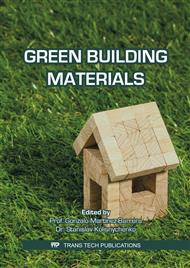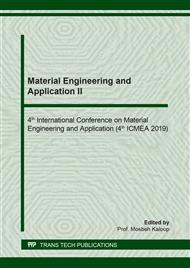p.144
p.150
p.155
p.161
p.166
p.171
p.177
p.182
p.188
Hemp Fiber Reinforced Geopolymer Composites: Effects of NaOH Concentration on Fiber Pre-Treatment Process
Abstract:
High demand for using parts of natural materials, e.g., cores, fibers or leaves, as alternative additives are being increased. The main reasons are that natural materials can be served as renewable and eco-friendly choices such a sustainable development. Nevertheless, some limitations of applying those natural products, such as biodegradation, UV degradation, or weak bonding, are raised and need to be modified before further handling. One of the modification techniques for bio-based materials is chemical treatment by using alkaline solution (alkalization). Treatment process allows the plant's fiber to have fewer impurities as well as to increase the bonding on its contacting surface area. This research focuses on (i) effects of NaOH solution concentration on the pre-treatment properties of hemp fibers and (ii) self-treatment behavior of hemp fiber in geopolymer composites. The results show that the concentration of NaOH solution directly affected the pre-treatment process of hemp fiber as higher concentration from 1, 3, 5, 8, 10 to 12 Molar provided more vanishing level of fiber impurities, indicated by Contact Angle (CA) measurement and Fourier Transform Infrared (FT-IR) Spectroscopy analysis. With the concept of alkaline treatment, the self-treatment process was therefore applied for hemp fiber incorporated in alkaline-activated geopolymer matrix. The results illustrate the self-treatment behavior of hemp fiber in geopolymer composites, which could improve the final performances of the hardened products without conventional pre-treatment process.
Info:
Periodical:
Pages:
166-170
Citation:
Online since:
May 2020
Keywords:
Price:
Сopyright:
© 2020 Trans Tech Publications Ltd. All Rights Reserved
Share:
Citation:



